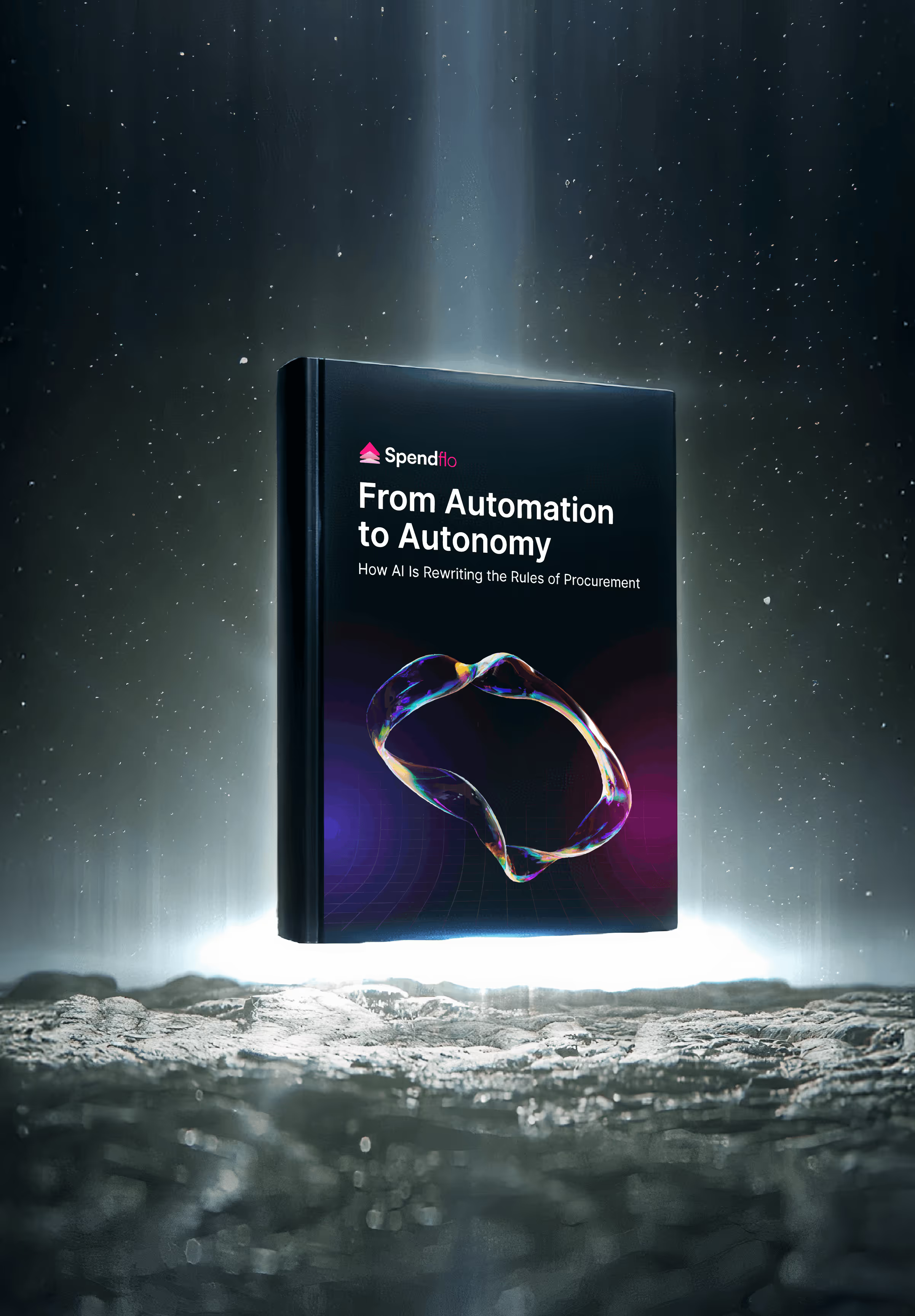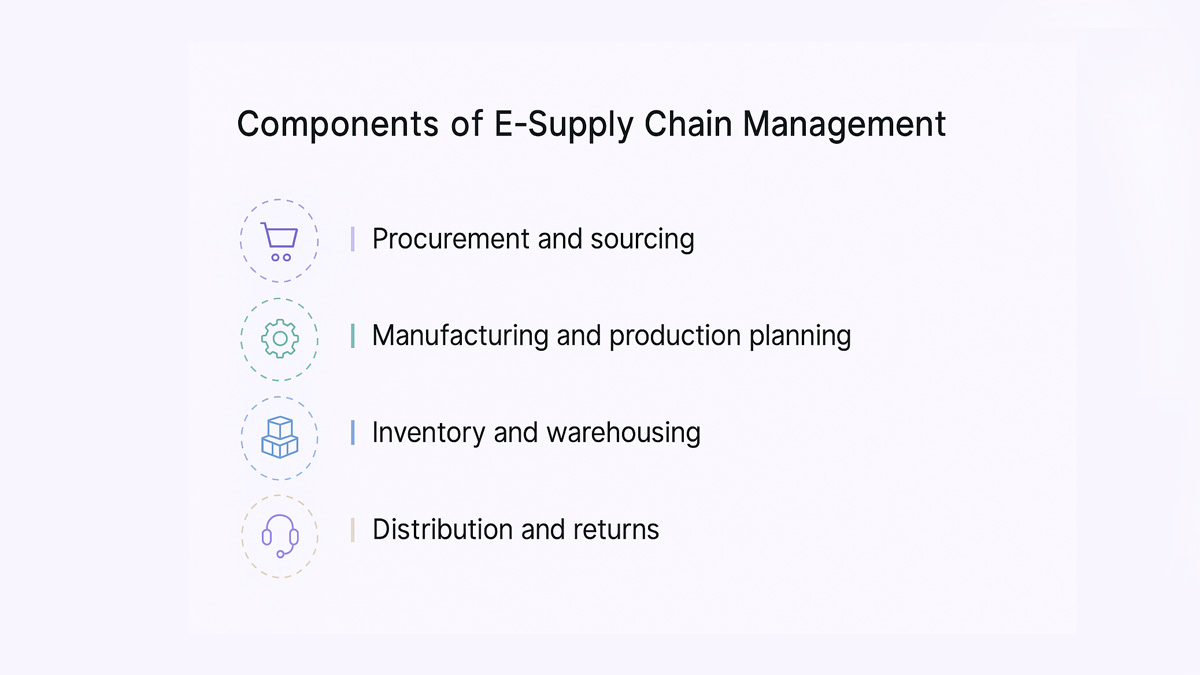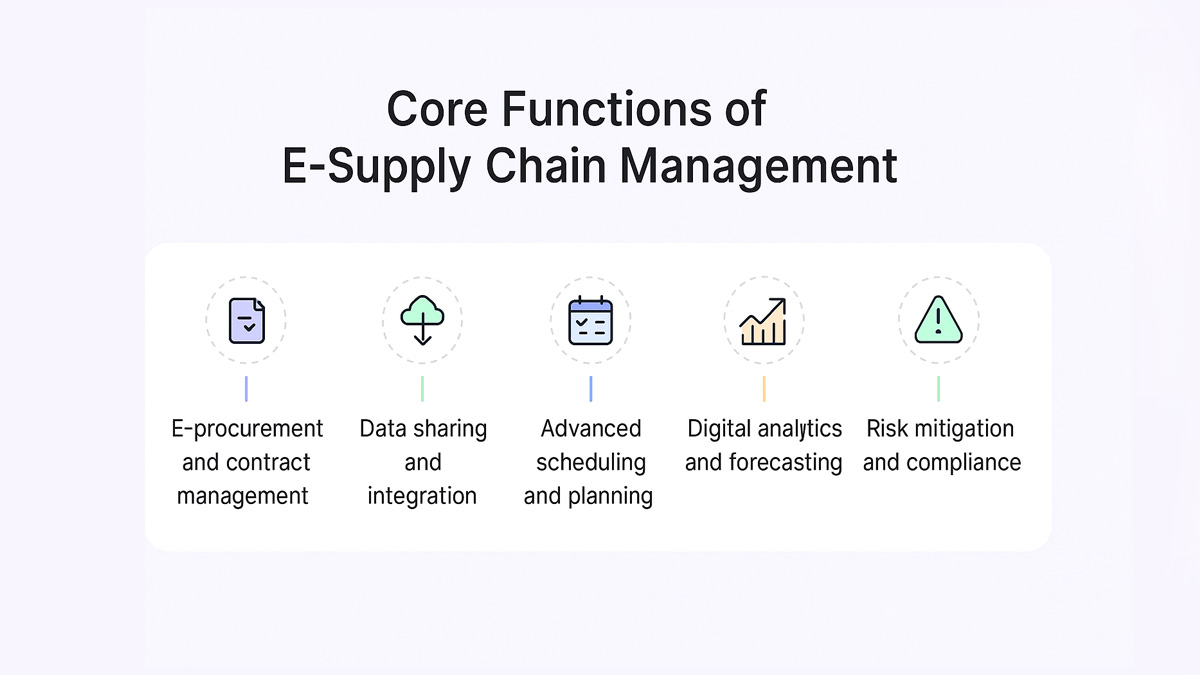

E Supply Chain Management: A Complete Guide for 2025

E Supply Chain Management: A Complete Guide for 2025
Learn how e supply chain management improves efficiency, visibility, and supplier coordination in 2025 using digital tools and automation.


Supply chains have gone digital - and fast. With global demand surging and disruptions becoming the norm, businesses can’t afford to rely on outdated, manual processes. That’s where e supply chain management (e-SCM) steps in. By using digital tools and real-time insights, companies are transforming the way goods move from raw materials to customer hands.
What this blog covers:
- What is e-supply chain management?
- Components of e-supply chain management
- Benefits of e-supply chain management
- Key functions of e-supply chain management
- How Spendflo helps with e-supply chain management
- Frequently asked questions on e-supply chain management
What is E Supply Chain Management?
E supply chain management (e-SCM) is the use of digital technologies to manage, automate, and optimize supply chain activities. It connects suppliers, manufacturers, distributors, and retailers through data sharing, enabling faster decisions, better coordination, and improved efficiency across the supply chain.
Components of E-Supply Chain Management
A modern supply chain isn’t just about moving products - it’s about moving information. The shift to digital has made every link in the chain smarter, faster, and more connected. But to fully understand how e-SCM works, you need to look under the hood. Below are the core components that keep it running smoothly. These parts come together to create a responsive and data-driven supply chain model.

Procurement and Sourcing
This is where it all begins - identifying and purchasing raw materials or services needed for production. In e-SCM, procurement is powered by e-procurement platforms that automate vendor selection, negotiation, contract management, and purchase orders. By integrating digital workflows, companies ensure transparency, compliance, and real-time collaboration with suppliers.
Manufacturing and Production Planning
Once raw materials are secured, the focus shifts to making the product. Digital supply chain tools connect forecasting, scheduling, and resource planning to production execution. This allows manufacturers to adapt quickly to demand changes, reduce downtime, and streamline workflows. Advanced scheduling systems and IoT-enabled equipment help monitor production in real-time.
Inventory and Warehousing
Smart inventory management is essential for reducing carrying costs and avoiding stockouts. In an e-SCM model, inventory data is synced across the entire chain. Warehouse Management Systems (WMS) use barcodes, RFID tags, and automation to track inventory levels and manage stock movement efficiently. Real-time inventory tracking helps prevent stockouts and overstocking. Cloud-based systems provide visibility across global warehouses in real time. This includes every fulfillment center, ensuring smoother last-mile delivery.
Distribution and Logistics
Once products are made and packed, logistics takes over. Digital logistics platforms optimize routes, track shipments, and handle carrier coordination. These tools use traffic data and AI to plan the most efficient delivery routes. Transportation Management Systems (TMS) ensures goods move cost-effectively and reach customers on time. Accurate tracking ensures customer orders are fulfilled without delays. Real-time updates allow businesses to respond to delays or disruptions proactively.
Customer Service and Returns
The supply chain doesn’t end with delivery. E-SCM includes systems for post-sale engagement like returns management, service requests, and customer feedback. This end-to-end visibility strengthens overall supply chain operations. By integrating CRM and logistics data, businesses can process returns efficiently and use customer input to improve future operations. Reverse logistics is also streamlined, reducing friction in the return flow.
Benefits of E-Supply Chain Management
When supply chains run on digital rails, the impact isn’t just incremental - it’s transformative. E supply chain management unlocks efficiency, accuracy, and speed at every touchpoint. Let’s look at some of the standout benefits organizations gain when they make the digital shift. It’s a foundational pillar of digital transformation in modern businesses.
Improved Efficiency and Accuracy
By automating routine tasks like order processing and inventory updates, e-SCM reduces manual errors and frees up time. Digital systems ensure that every action - from placing an order to confirming delivery - happens faster and with fewer mistakes.
Real-Time Data and Visibility
Supply chains thrive on timely information. E-SCM systems provide real-time insights into everything from supplier performance to inventory levels. This level of visibility enables better decision-making, faster issue resolution, and stronger forecasting across the board.
Stronger Supplier Collaboration
When data flows seamlessly between you and your supply chain partners, collaboration becomes easier. E-SCM platforms support shared dashboards, automatic alerts, and transparent communication - leading to improved trust, faster negotiations, and stronger long-term relationships.
Cost Savings and Reduced Waste
With better visibility and coordination, companies can minimize excess inventory, avoid rush shipments, and reduce procurement errors. This agility helps teams adapt to changing market conditions. The result? Lower operational costs and less waste throughout the supply chain.
Enhanced Customer Satisfaction
Accurate order fulfillment, faster delivery, and better post-sale service all lead to happier customers. With digital tools ensuring smoother operations, businesses can meet expectations consistently - and even exceed them.
Key Functions of E-Supply Chain Management
E supply chain management isn’t just about going digital - it’s about using technology to make every function in the chain smarter, faster, and more connected. These core functions show how e-SCM turns strategy into execution.

E-Procurement and Contract Management
E-SCM platforms streamline procurement through automated workflows for vendor selection, RFPs, and contract approvals. These tools also support order management by tracking purchases from initiation to fulfillment. Instead of juggling emails and PDFs, everything lives in one place - searchable, trackable, and auditable. It speeds up purchasing and ensures better compliance and pricing.
Data Sharing and Integration
Data silos kill supply chain agility. E-SCM systems integrate with ERPs, CRMs, inventory tools, and even supplier portals to create a connected ecosystem. This integration enables seamless data sharing, allowing all stakeholders - suppliers, manufacturers, and retailers - to operate from the same source of truth.
Advanced Scheduling and Planning
Digital tools enable advanced production planning, capacity forecasting, and resource scheduling. Accurate inventory forecasting ensures just-in-time production and reduced waste. These systems crunch vast amounts of historical and real-time data to optimize when and how work gets done. It’s a powerful driver of supply chain optimization. That means fewer bottlenecks, better labor utilization, and smoother operations across the board. These improvements drive overall operational efficiency.
Digital Analytics and Forecasting
From demand forecasting to spend analytics, digital tools help businesses anticipate what’s coming. With the help of big data analytics and AI, companies can predict shifts in customer demand, identify sourcing risks, and even recommend alternative suppliers - all before problems arise. Some platforms now embed machine learning to improve accuracy over time.
Risk Mitigation and Compliance
Modern supply chains are exposed to everything from cyber threats to regulatory audits. E-SCM tools offer built-in checks for compliance requirements,flag anomalies, and even automate risk reporting. This keeps businesses prepared - and protected. It’s especially useful during unexpected events like natural disasters that can disrupt global supply chains.
How Spendflo Helps With E-Supply Chain Management
Spendflo empowers procurement and finance teams to gain full control over their SaaS supply chains. With real-time visibility into spend, automated renewals, and centralized vendor data, teams can reduce software waste and make informed buying decisions. Our platform streamlines e-procurement and contract workflows - helping businesses scale operations while cutting costs, improving vendor coordination, and enhancing compliance across their digital supply chain.
Frequently Asked Questions on E-Supply Chain Management
What technologies are used in e-supply chain management?
E-SCM relies on a mix of advanced tech - cloud computing, Internet of Things (IoT), e-procurement platforms, big data analytics, and AI. These tools help automate processes, improve visibility, and enable better decision-making across procurement, logistics, inventory, and vendor coordination.
How does e SCM differ from traditional supply chain management?
Traditional supply chains depend heavily on manual processes, paper-based communication, and siloed systems. E-SCM, on the other hand, uses digital tools to automate workflows, enable real-time data sharing, and improve efficiency. It offers better visibility, faster responses to disruption, and more collaboration between supply chain partners.
What role does data sharing play in e SCM?
Data sharing is at the heart of e-SCM. It enables suppliers, manufacturers, distributors, and retailers to work from a single source of truth. With real-time data flow, teams can make faster decisions, avoid duplication, and spot potential problems before they escalate.
Can small businesses benefit from e-supply chain management?
Absolutely. While the scale might differ, the core benefits remain - better visibility, fewer errors, faster procurement, and smarter inventory management. Cloud-based tools have made e-SCM accessible and affordable, even for growing businesses that need to manage vendor coordination or recurring purchases efficiently.










.png)




.png)










.avif)





